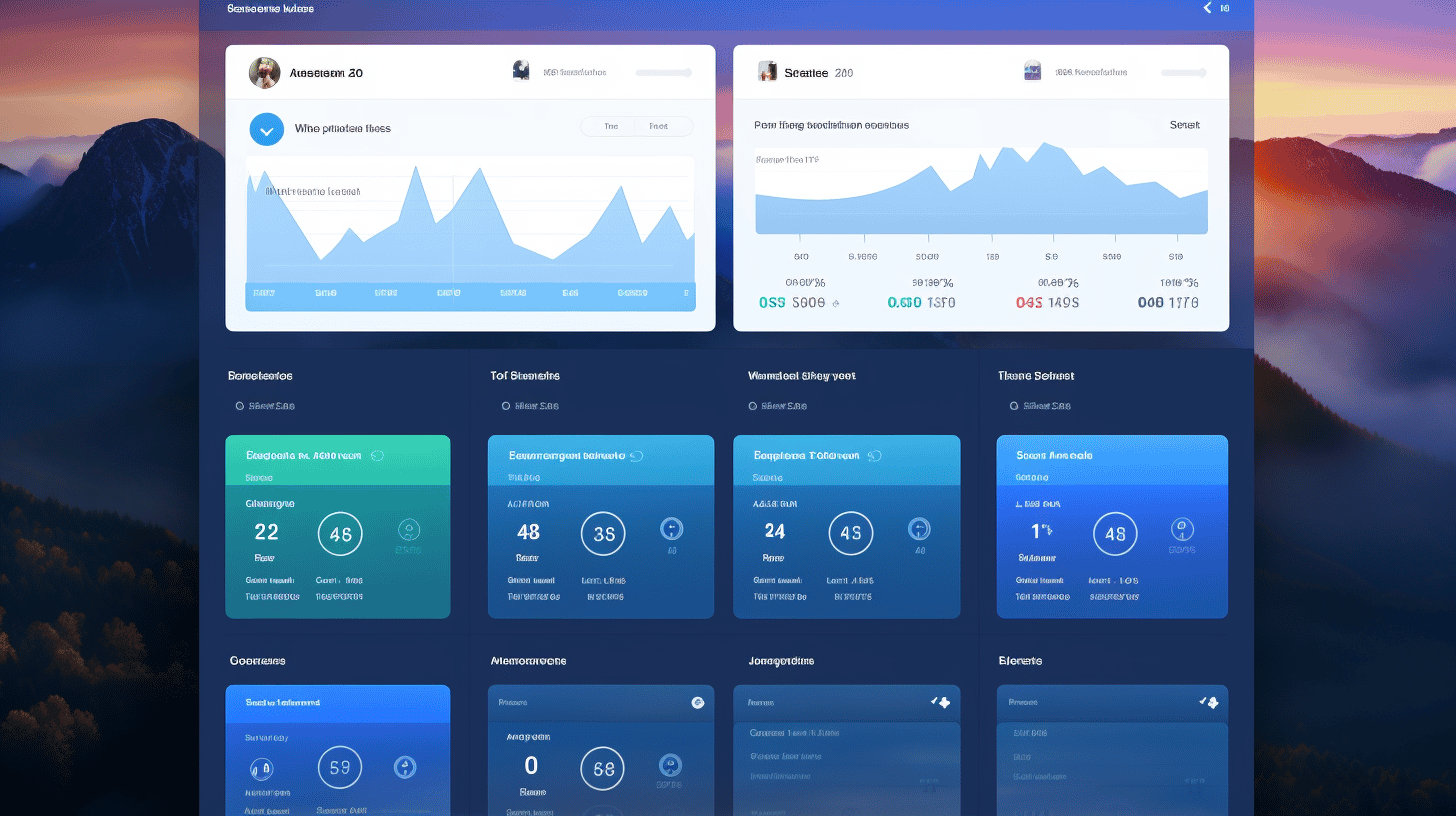在当今的数字环境中,企业严重依赖其在线业务,因此网站设计和在线安全的交集变得越来越重要。精心设计的网站不仅可以吸引访客,还可以确保流畅且引人入胜的用户体验。但是,如果没有采取足够的安全措施,网站可能会容易受到各种网络威胁,从而使用户的个人信息和企业本身面临风险。
在本文中,我们将探讨与网页设计和在线安全相关的基本术语,并深入探讨两者之间错综复杂的相互作用。我们将讨论网页设计选择如何对在线安全产生重大影响,以及应纳入设计过程的安全功能。此外,我们将探讨优先考虑安全性的网页设计最佳实践,并强调在线安全在建立用户信任和信心、保护品牌声誉和确保法律合规性方面发挥的关键作用。
通过了解网页设计与网络安全之间的关系,企业和个人可以创建不仅外观美观,而且优先考虑用户安全和隐私的网站。所以,让我们深入探讨这个迷人而关键的话题,探索网页设计和网络安全的世界是如何交织在一起的。💻🔒
要理解的基本术语:网页设计和在线安全
在当今的数字时代,网页设计和网络安全是两个密不可分的关键要素。无论您是企业主、自由职业者还是普通互联网用户,对这些术语及其重要性有基本的了解都是必不可少的。在本文中,我们将探讨网页设计和网络安全的定义,并深入探讨为什么它们在网络世界中如此重要。那么,让我们开始吧!
1. 网页设计:定义和意义
网页设计包括网站的创建和维护。它涉及各个方面,包括布局、配色方案、排版、用户体验等。关键在于设计一个视觉上吸引人且功能齐全的网站,吸引访客并有效地代表品牌。网页设计不仅仅是让事物看起来漂亮;它还注重创造无缝的用户体验并确保轻松导航。
精心设计的网站可以成为企业的强大工具,作为展示产品、提供信息和与客户互动的平台。这是访客对品牌或企业的第一印象,设计不佳的网站可能会赶走潜在客户。这就是为什么网页设计在建立信誉、建立信任以及最终增加转化率和收入方面发挥着至关重要的作用。
想要了解更多有关网页设计的知识?查看 托管WP网页设计 获得全面的信息、提示和资源。
2. 在线安全:定义和重要性
在线安全是指为保护敏感信息和确保通过互联网传输的数据的隐私性和完整性而采取的措施。随着对技术的依赖性不断增加以及在线存储和交换的数据量巨大,对强大的在线安全的需求变得比以往任何时候都更加重要。
网络攻击、数据泄露和身份盗窃是当今数字环境中的持续威胁。加密、安全协议、防火墙和多因素身份验证等在线安全措施对于保护个人和企业数据免遭未经授权的访问至关重要。
保持高水平的在线安全对于个人和组织都至关重要。它不仅可以保护敏感信息,还有助于维护客户、客户和合作伙伴的信任。在数据泄露频频成为头条新闻的时代,投资在线安全不仅仅是一种选择,而是一种必需。
请记住,了解网页设计和网络安全是有效安全地浏览网络世界的关键。通过牢牢掌握这些概念,您可以做出明智的决定,保护自己和您的企业,并确保良好的在线体验。
因此,无论您是希望改造网站的企业主,还是关注网络安全的个人,有关网页设计和网络安全的知识都将使您能够做出正确的选择并在数字领域保持领先一步。
网页设计与网络安全之间的相互作用
在当今的数字环境中,网页设计和网络安全密不可分,以确保安全且用户友好的在线体验。精心设计的网页设计不仅能吸引用户,而且在保护他们的个人信息和保护他们免受网络威胁方面也发挥着至关重要的作用。让我们探讨一下网页设计与网络安全之间的复杂关系,以及网页设计师在创建安全的在线环境时必须牢记的注意事项。
网页设计对网络安全的影响
网页设计包含各种元素,例如布局、颜色、排版和视觉效果,以创建美观且实用的网站。然而,这不仅仅是美观。在开发过程中做出的设计选择会显著影响网站的整体安全状况。方法如下:
- 用户体验和信任:设计良好的网站会给用户带来信任和信心。当访问者在浏览时感到安全时,他们更有可能与网站互动并转化为客户。相反,设计不佳的网站,导航混乱且链接断开,可能会引发安全问题并导致用户放弃该网站。
- 移动设备的响应式设计:随着移动设备使用率的上升,网站必须具有响应性并适应不同的屏幕尺寸。响应式设计不仅可以增强用户体验,还可以提高安全性。适合移动设备的网站不易出现安全漏洞,并为旅途中的用户提供流畅、安全的浏览体验。
- 安全登录和身份验证:设计强大的登录和身份验证系统对于保护用户帐户至关重要。实施强密码要求、多因素身份验证和用户友好的密码重置流程都是有助于降低未经授权访问风险的设计考虑因素。
- 清晰传达安全实践:网站设计在传达有关网站安全实践的信息方面起着至关重要的作用,例如使用 SSL/TLS 加密、安全支付网关和数据保护措施。透明地传达这些安全功能有助于用户更放心地分享他们的个人信息。
网页设计中的在线安全考虑
在开发网站时,网页设计师必须优先考虑网络安全。以下是需要牢记的一些关键注意事项:
- 安全编码实践:利用安全编码实践来最大限度地减少漏洞并防范常见的基于 Web 的攻击,例如跨站点脚本 (XSS) 和 SQL 注入。定期更新和修补框架、插件和 CMS 平台以解决任何安全漏洞。
- SSL/TLS 加密:实施 SSL/TLS 加密对于确保在用户浏览器和网站之间传输的敏感信息安全至关重要。这可确保数据保持私密,并防止被恶意行为者拦截。
- 数据隐私和保护:设计网站时要考虑数据隐私。尽量减少不必要的个人信息的收集,并在隐私政策中明确说明如何收集、存储和保护用户数据。遵守《通用数据保护条例》(GDPR)等法规表明了对用户隐私的承诺。
- 定期安全审计和渗透测试:定期进行安全审计和渗透测试,以识别漏洞、评估安全措施的有效性并主动解决任何弱点。这有助于领先一步应对潜在威胁并确保持续的安全改进。
请记住,网页设计和在线安全并不是孤立的概念,而是成功且安全的在线形象的相互依存的组成部分。通过在网页设计过程中考虑安全方面,设计师可以创建具有视觉吸引力的网站,这些网站优先考虑用户的信任并保护他们的敏感信息。在当今的数字环境中,采用整体的网页设计方法,注重美观和安全至关重要。
网页设计中的安全功能
在日益数字化的世界中,安全性对于网页设计至关重要。随着网络威胁的增加,企业必须优先实施强大的安全措施来保护其网站和用户数据。在本文中,我们将探讨一些应纳入网页设计的关键安全功能,以确保为用户提供安全可靠的在线体验。
🔒 HTTPS 和 SSL 证书
网页设计中的一个基本安全功能是使用 HTTPS(超文本传输协议安全)和 SSL(安全套接字层)证书。这些技术提供加密和身份验证,在用户的浏览器和他们访问的网站之间提供安全连接。以下是这很重要的原因:
- 数据加密:HTTPS 确保在浏览器和网站之间传输的任何数据都经过加密,这使得黑客极难拦截和解密信息。
- 网站真实性:SSL 证书可验证网站的身份,向用户保证他们访问的是正规网站,而不是恶意冒名顶替者的网站。
- 信任与可信度:HTTPS 和 SSL 证书的存在让用户相信,在与网站交互时,他们的敏感信息(例如密码或付款详细信息)受到保护。
🛡️ 后端安全措施
虽然 HTTPS 和 SSL 证书提供了安全的连接,但网页设计师还需要专注于实施强大的后端安全措施。这涉及保护存储和处理敏感用户数据的服务器和数据库。一些重要措施包括:
- 定期更新和补丁:确保服务器软件、框架和内容管理系统是最新的,有助于防止已知的漏洞和安全漏洞。
- 安全文件权限:将文件访问权限限制为仅需要的人员,可防止未经授权的个人篡改或获取敏感数据。
- 恶意软件检测和预防:实施反恶意软件解决方案并定期进行扫描可以帮助识别并消除潜在威胁,从而防止它们对网站或其用户造成危害。
🔐 前端安全实践
前端安全在保护用户与网站交互时免受潜在威胁方面起着至关重要的作用。以下是一些需要考虑的基本前端安全实践:
- 输入验证:正确验证用户输入并执行严格的输入约束可以防止 SQL 注入或跨站点脚本攻击等恶意行为。
- 网站安全测试:定期进行全面的安全审计和渗透测试有助于识别漏洞,确保能够及时解决。
- 内容安全政策:实施内容安全策略通过定义各种网络资源的可接受来源有助于防止恶意脚本或有害内容。
👤 用户身份验证和授权
用户身份验证和授权是确保只有授权人员才能访问网站特定功能或部分的关键因素。实施强大的用户身份验证方法(例如双因素身份验证和密码复杂性要求)可以显著增强安全性。此外:
- 基于角色的访问控制:根据用户角色定义不同级别的访问权限有助于防止未经授权访问网站的敏感区域。
- 密码哈希:以散列和加盐格式存储用户密码可以增加一层额外的安全性,使得黑客在发生数据泄露时更难破译密码。
通过将这些安全功能融入到网站设计中,企业可以保护其网站并保护用户数据免受潜在威胁。实施多层安全方法可增强对网络攻击的整体防御能力,为用户提供安全可靠的在线体验。
提高安全性的网页设计最佳实践
随着网络安全威胁和数据泄露的不断增加,优先考虑网站安全变得比以往任何时候都更加重要。作为一名网页设计师,实施最佳实践至关重要,这些最佳实践不仅可以创建具有视觉吸引力的网站,还可以保护敏感信息。通过遵循这些网页设计最佳实践来提高安全性,您可以帮助保护客户的网站并增强整体用户体验。
使用信誉良好的 CMS
设计网站时,您要做的第一件事之一就是选择内容管理系统 (CMS)。虽然有很多选择,但选择信誉良好的 CMS 可以显著增强您网站的安全性。原因如下:
- 强大的安全功能: 信誉良好的 CMS 平台(例如 WordPress)具有内置的安全功能,并不断发布更新以解决漏洞和修补安全漏洞。
- 充满活力的社区: 流行的 CMS 平台通常拥有庞大而活跃的开发者社区,他们相互协作以快速识别和修复安全问题。
通过选择信誉良好的 CMS,您可以确保您的网站建立在安全的基础上,从而降低潜在安全漏洞的风险。
频繁的安全更新和补丁
作为网页设计师,及时了解最新的安全更新和补丁至关重要。这些更新通常可以解决漏洞并添加新的安全功能。确保定期更新 CMS 以及您在网站设计中使用的任何插件或主题。
- 保持 CMS 和插件为最新版本: 定期检查更新并及时安装以确保最新的安全增强功能。
- 删除未使用的插件和主题: 如果不定期更新,未使用的插件和主题可能会成为漏洞。删除它们以降低潜在安全漏洞的风险。
通过定期更新和修补,您可以加强网站的安全性并保护其免受潜在威胁。
安全密码实践
弱密码是黑客未经授权访问网站的最简单方法之一。作为一名网页设计师,为客户的网站实施安全密码实践至关重要。以下是一些建议:
- 密码复杂度: 鼓励您的客户使用包含大写和小写字母、数字和特殊字符的强密码。
- 密码管理器: 建议使用密码管理工具来生成并安全存储复杂密码。这可以降低用户在多个平台上重复使用弱密码的可能性。
实施安全密码实践将为您的客户的网站增加额外的保护层,使攻击者更难获得未经授权的访问。
定期安全审核
定期进行安全审核对于确保网站的持续安全至关重要。通过定期进行审核,您可以识别并解决网站安全中的任何漏洞或弱点。以下是安全审核中应包含的一些要素:
- 漏洞扫描: 利用自动化工具扫描潜在的漏洞,例如过时的插件或弱密码。
- 代码审查: 检查网站代码是否存在潜在的安全漏洞或可利用的区域。
- 用户访问控制: 定期审查和更新用户访问控制,以确保只有授权个人才拥有必要的权限。
通过定期进行安全审核,您可以主动识别和减轻任何潜在的安全风险,从而确保客户网站的安全。
总之,实施这些网页设计最佳实践以提高安全性将有助于保护客户的网站免受网络安全威胁,增强用户信任并提供安全的浏览体验。通过使用信誉良好的 CMS 平台、及时了解安全更新、实施安全密码实践以及定期进行安全审核,您可以构建不仅外观美观而且安全的网站。
在线安全对网页设计的影响
在当今的数字时代,网络安全至关重要。随着网络威胁的增加,企业必须优先保护用户数据并确保其网站的安全。从网页设计的角度来看,采用强大的安全措施不仅有助于防止数据泄露,而且还对用户信任、品牌声誉和法律合规性等各个方面产生重大影响。让我们深入探讨网络安全如何影响网页设计。
用户信任和信心
用户信任对于任何网站或在线业务的成功都至关重要。当访问者感到安全时,他们更有可能参与、分享敏感信息和进行金融交易。另一方面,对实施的安全措施缺乏信任可能会导致用户流失,从而导致失去机会和收入。以下是网络安全如何影响用户信任:
- 安全套接字层 (SSL) 认证: SSL 证书表明网站已实施加密协议,确保用户浏览器和服务器之间传输的数据的机密性。在地址栏中看到挂锁 🔒 会让用户充满信心,表明他们的信息受到保护。
- 强密码策略: 实施强密码要求可增强用户帐户的整体安全性。鼓励用户创建复杂的密码并定期更改密码可降低未经授权访问的风险。
保护品牌声誉
建立强大的品牌声誉需要时间、精力和资源。一次安全漏洞就可能瞬间损害品牌声誉,从而严重损害企业的信誉。以下是网络安全对品牌声誉的影响:
- 数据隐私: 用户越来越关心他们的个人信息是如何被收集、存储和使用的。通过优先考虑数据隐私和遵守相关法规(如 GDPR 或 CCPA),企业可以将自己定位为致力于保护用户信息的值得信赖的实体。
- 快速事件响应: 如果不幸发生安全事件,迅速透明的响应对于维护品牌声誉至关重要。及时通知客户有关违规行为的信息、为他们提供保护帐户的步骤以及采取措施防止未来发生此类事件,都有助于重建信任并减轻声誉损害。
法律合规与法规
确保遵守相关网络安全法律法规不仅出于法律原因至关重要,而且有助于建立安全的在线形象。不履行法律义务可能会导致法律麻烦、巨额罚款和失去客户信任。以下是网络安全与法律合规性的关系:
- 数据保护法: 世界各国政府都颁布了数据保护法,以保护用户数据并要求企业负责保护数据。遵守这些法律可确保合法收集和处理用户信息,为用户提供更安全的在线服务环境。
- 无障碍合规性: 作为网页设计的一部分,考虑无障碍标准可确保残障人士能够轻松访问和浏览网站。这包括实施适当的安全措施来保护所有用户的数据,无论他们的能力如何。
总之,网络安全不仅仅是一个技术方面,它是网页设计不可或缺的一部分。通过优先实施强大的安全措施,企业可以增强用户信任,保护其品牌声誉,并确保遵守适用法规。将网络安全纳入网页设计过程的每个方面对于为用户创造安全可靠的在线体验至关重要。
结论
总之,网页设计和网络安全的结合对于打造成功且安全的在线形象至关重要。通过了解网页设计的意义和网络安全的重要性,企业可以保护其网站并赢得用户的信任。
在网页设计中实现安全功能,例如 HTTPS 和 SSL 证书、后端和前端安全措施以及用户身份验证和授权,对于保护敏感信息和防止未经授权访问您的网站至关重要。
遵守网页设计的最佳实践,例如使用信誉良好的 CMS、定期更新和修补安全漏洞、实施安全密码实践以及进行定期安全审核,可以显著提高您网站的整体安全性。
此外,网络安全对网站设计有直接影响,因为它会影响用户的信任和信心、保护品牌声誉以及确保遵守法律法规。通过优先考虑网络安全,企业不仅可以保护用户,还可以保持良好的在线声誉并遵守行业法规。
总体而言,在当今的数字环境中,网页设计与网络安全之间的相互作用至关重要。通过考虑这两个方面并实施必要的安全措施,企业可以创建安全且用户友好的网站,从而让用户充满信心并有效地保护有价值的信息。
对于可信赖且可靠的托管 WordPress 云托管平台,简化基础设施并提供专家 24/7/365 WordPress 支持,请考虑 Managed-WP.™。凭借其主动监控、备份管理和补丁管理服务,您可以放心,您的网站处于安全状态。请访问他们的网站 managed-wp.com 了解更多信息。
常见问题
- 网页设计如何影响网络安全?
网页设计可以增强或损害在线安全性,这取决于使用安全编码实践、实施 SSL 证书、定期更新和漏洞测试等因素。
- 将安全性融入网页设计的一些最佳实践是什么?
将安全性集成到网页设计中的一些最佳实践包括使用强大而独特的密码、实施双因素身份验证、使用安全托管服务提供商、定期更新 CMS 和插件以及进行定期安全审核。
- 设计不良的网站会带来安全风险吗?
是的,设计不良的网站可能会带来安全风险。网页设计中的漏洞可能会让黑客更容易利用并获得未经授权的访问,从而导致数据泄露、恶意软件注入和其他安全漏洞。
- 我如何确保我的网站免受潜在威胁?
为了确保您网站的安全,您应该保持所有软件为最新版本,选择信誉良好的托管服务提供商,定期备份您的网站,使用 SSL 证书,实施防火墙和安全插件,并随时了解最新的安全实践。
- 网页设计师应该注意哪些常见的安全漏洞?
Web 设计师应该注意常见的安全漏洞,例如跨站点脚本 (XSS)、SQL 注入、不安全的文件上传、不安全的直接对象引用 (IDOR) 以及对用户输入的验证和清理不充分。



















